Background
Srinagar offers different meanings and significance for different people. The city becomes a mind-refreshing experience for introverts, and it gels so well for extroverts that they sense a deep connection with the city.
This more than 2000 years old city with a written history and a vital link connecting the Silk Route is incomplete without its geographical beauty, rich cultural heritage, historical architecture, age-old traditions & beliefs, indigenous food habits, handicrafts, and never-ending hospitality.
In 2021, the United Nations Educational, Scientific and Cultural Organization (UNESCO) picked up Srinagar City as part of the creative city network under the Crafts and Folk Arts category.
History
According to Kalhana's Rajatarangini, the word Srinagar is a Sanskrit word 'Shri-nagara,' which translators understand as the "City of Sun" or the "City of Shri".
The history of Srinagar would be incomplete without discussing the city's earliest settlement, known as 'Shahr-e-Khass' or Downtown. It is home to exquisite masjids, shrines, temples, antique buildings built in a close-knit community, and the main seven bridges that connect the two sides of the Jhelum River. All of them depict the rich history and fascinating stories of this ancient city and its inhabitants.
Srinagar was founded by King Pravarsena II of the Vakataka dynasty about 2000 years ago. Srinagar has been ruled by great monarchs of tremendous empires over the centuries, including Hindu, Muslim, and Sikh rulers. Between the 3rd and 1st centuries BCE, King Ashoka of the Mauryan empire, a renowned proponent of Buddhism, introduced Buddhism to the valley. In Srinagar's Harwan city, there is evidence that the town was ruled by the Kushans in the first century AD.
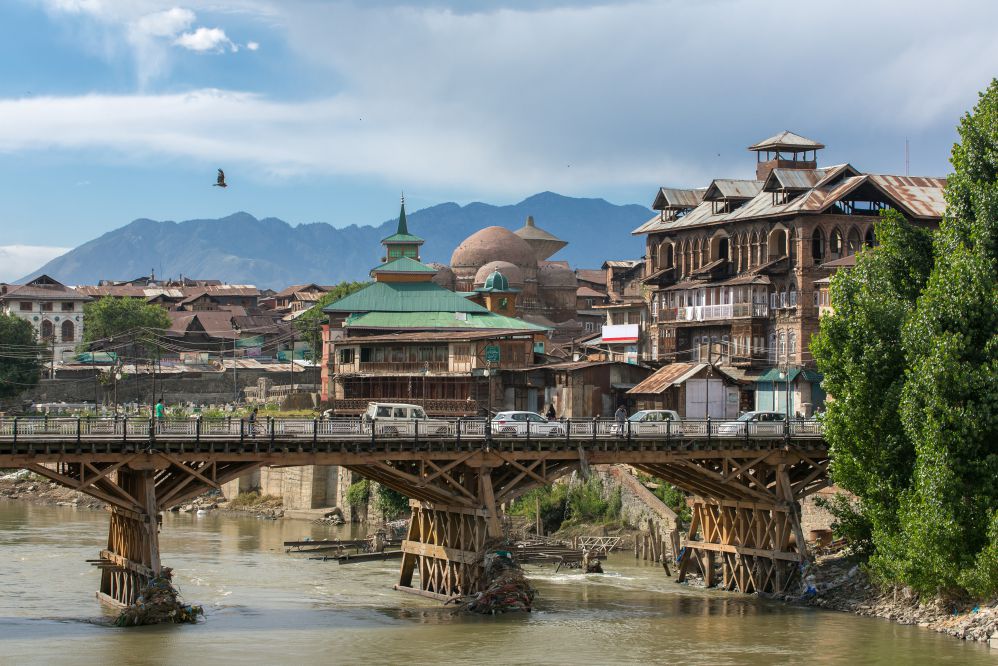
Take a walk through the Mughal Gardens
Srinagar's Mughal-era gardens have been well-preserved in all their splendor until this day. A walk in the park, surrounded by brilliant flowers with their scent filling the air, is enough to transport one into a romantic reverie. Set against the backdrop of Dal Lake, the tiered lawns with fountains and vibrant flower beds create a breathtakingly beautiful landscape.
Mughal Gardens found here are Nishat Bagh, Shalimar Bagh, Chashme Shahi, and Naseem Bagh. All the former three gardens were built on the Persian architectural principle mainly by Emperor Jahangir and his son Shah Jahan. They have their own Charbagh style, which is characterized by a square plan with four evenly divided portions and a center water channel that runs across the space.
Tour the houseboats of Nigeen Lake
The main tourist attraction, Lake Nigeen, is located east of Srinagar and is known for its crystal clear waters, as opposed to Dal Lake. On the margins, there are some willow and poplar trees. Nigeen Lake gets its name from the midnight blue water that flows from Dal Lake.
Chashm-e-Shahi
Chashma-e-shahi, which means royal spring and is called after the natural spring that originates here, is one of the most captivating Mughal gardens. The spring, which was discovered by Rupa Bawani, a prominent female saint of Kashmir, is said to have healing capabilities. In 1632 AD, Mughal Emperor Shah Jahan directed his governor, Ali Mardan, to construct a garden for his oldest son, Dara Shikoh, around the spring.
According to local legend, the water from this spring is so pure that it was drunk by Jawaharlal Nehru, India's first Prime Minister, and his daughter Indira Gandhi. Chashma-e-shahi may be the smallest of all Mughal gardens of Srinagar, but it is rich with beauty and tranquillity. Its magnificent waterfalls, sculpted fountains, manicured lawns, and vibrant flowers are breathtaking. A visit to Kashmir is not complete without a stop at this lovely garden.
Attend the Tulip festival at Tulip Garden
The Indira Gandhi Memorial Tulip Garden, Asia's largest Tulip garden, is a seven-tiered garden on the foothills of the Zabarwan Range, some 13 kilometers from Srinagar's city center. The garden was previously known as Siraj Bagh. It was renamed after Indira Gandhi, India's first female Prime Minister, in 2007 and quickly became a popular tourist destination.
The seemingly unending green stretch of the Tulip Garden is dotted with 20 lakh flowers, including 40 different species of tulips. The bulbs for these multicolored tulip bulbs came from Amsterdam. Other flowers in the garden include hyacinths, narcissus, roses, ranunculus, and other ornamental plants, in addition to tulips. Visit the garden in March and April to see 2 million tulips blooming at the same time.
Nishat Bagh
Nishat Bagh in Srinagar is the second biggest Mughal garden in Kashmir, and is known as the "Garden of Gladness," "Garden of Bliss," or "Garden of Joy." Nishat Garden is located on the eastern side of the Dal lake, on its banks, with the Zabarwan mountains as a backdrop. Built by Asif Khan, elder brother of Mughal Empress Nur Jehan, in 1633, it is a 12 terraced garden, each representing a zodiac sign, bracketed by many Chinar and Cypress trees adorned with roses, lilies, and other exotic flowers. The Bagh was originally a unique private recreational zone for royals, comprising 46 acres. Roses, geraniums, asters, tall zinnias, and fluffy pink and white cosmos burn brightly in the flowerbeds.
Shalimar Garden
The construction of Shalimar Bagh began in the second century, under the reign of Pravarasena II, who also established the city of Srinagar from AD 79 to AD 139. He had built a cottage at the northeastern corner of Dal Lake and named it Shalimar. Many centuries later, King Zain ul Abidin built a canal and a dam there.
In AD 1619, Mughal Emperor Jahangir established the Shalimar garden for his wife Noor Jahan. During his reign, he would frequently travel to Srinagar in the summer to escape Delhi's oppressive heat. As a gift to his bride, Noor Jehan, he chose to create a full-fledged royal garden.
In the autumn, the garden's periphery, which is defined by huge Chinars, takes on a golden tint. During the summer, the Persian lilacs are a huge draw. Nishat and Shalimar gardens are also being protected and restored by the JSW Foundation. The local administration is working to have these gardens added to the list of UNESCO World Heritage Sites.
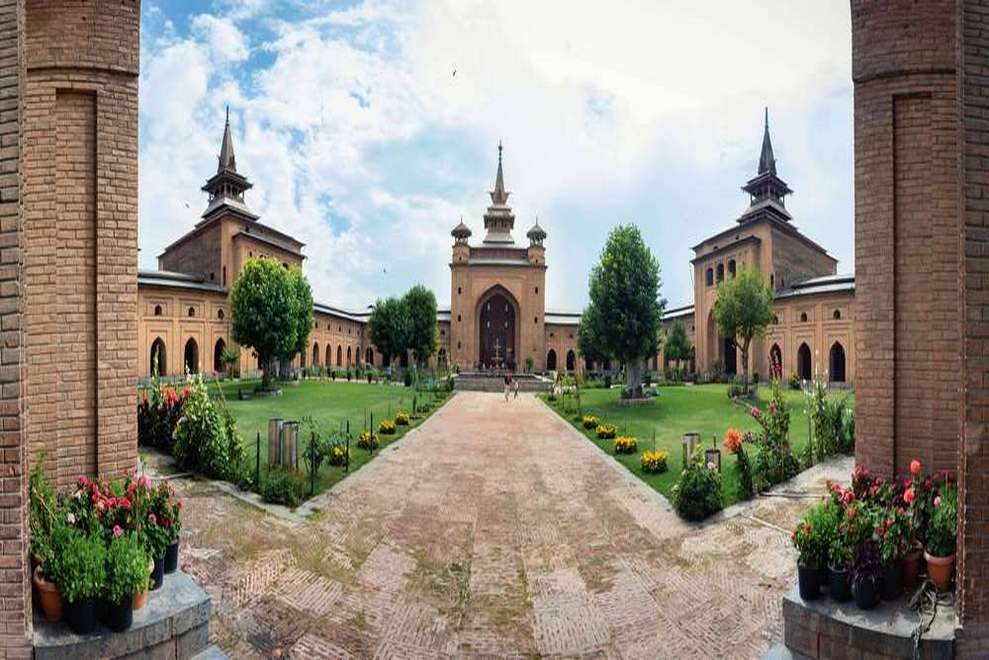
Jamia Masjid
The Jamia Masjid in Nowhatta, a district in the center of Srinagar's old city, is the largest mosque in Kashmir. Sultan Sikandar Shah Kashmiri erected it in 1402, more than 600 years ago. Sultan Sikandar commissioned it in 1394 CE, and it is an architectural gem from the Shahmir era. However, at the request of Mir Mohammad Hamdani, son of Mir Sayyid Ali Hamdani, it was completed in 1402 CE.
Jamia Masjid, which is located among the local marketplaces, is significantly influenced by Indo-Saracenic architecture. The construction is a quadrilateral with four minarets, based on the ancient Chaar Bagh layout. The minarets are connected by expansive halls with pyramidal tops. These roofs are supported by 378 deodar timber columns that finish in an open turret.
The mosque is a work of art, and over 3333 people can pray here at the same time. This mosque is remarkable in that, despite its location in the midst of the hustle and bustle of old bazaars, it provides quiet and inner calm to every visitor. Without a doubt, the massive mosque occupies a unique position in Kashmir's history, politics, and culture.
Holy Family Catholic Church
Holy Family Catholic Church is a century-old Roman Catholic church in Srinagar's Maulana Azad Chowk. It, along with All Saints Anglican Church, was founded in 1986 by Mill Hill missionaries as the major church for the minority Christian population.
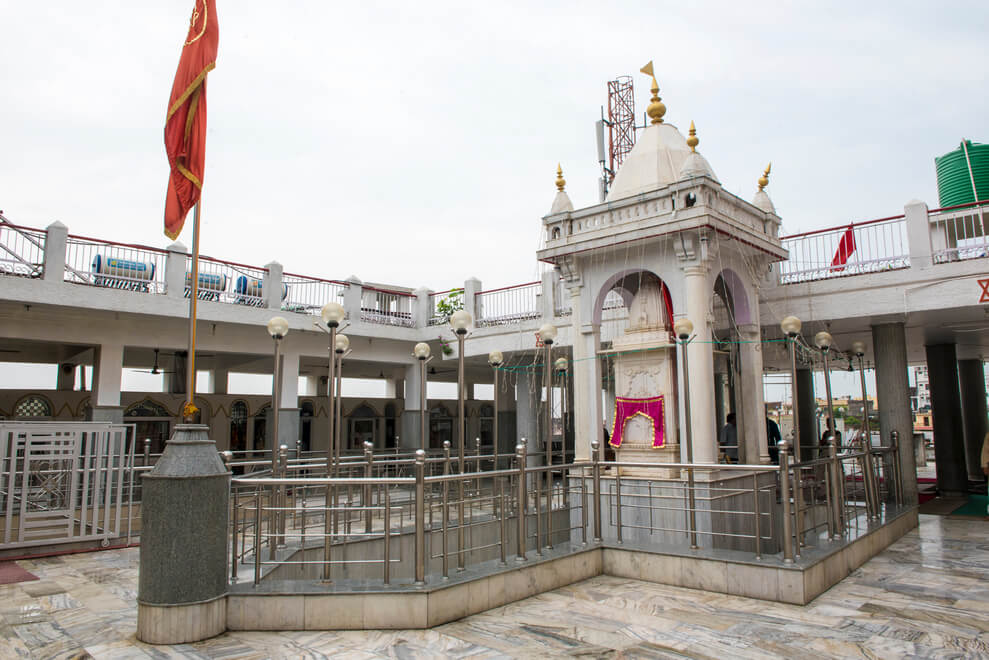
Kheer Bhawani Temple
Kheer Bhawani Mandir is a temple dedicated to Goddess Ragniya Devi near the TulMul village in Srinagar. The presiding deity here is said to be an incarnation of Devi Durga. The temple is the most revered site among the Kashmiri Hindus in the Valley, who hold the Goddess in the highest regard. The Supreme Goddess manifests herself in many Roop(forms). Under Ragniya, she is known to have many incarnations of Maa Durga. Ragniya in Kashmir is known as Tripura, whereas in Sri Lanka, she is referred to as Shyama.
The name 'Bhawani' refers to one of the many forms of Maa Durga. The one at Tul Mul Village is of 'Vaishnav Rupa'. Ravana fervently worshipped this form of Maa Durga. Pleased with his devotion, Maa appeared in Bhawani form and blessed him with her image to be installed in his kingdom. However, her pleasant stay was short-lived, for Ravana's brutality displeased Mata. And so she instructed Hanuman to fly her out of Lanka and chose her sacred abode near Tul Mul. Tul Mul in the local language refers to the Mulberry tree, which used to exist where the temple is.
Khanqah-e-Moula
The Khanqah-e-Moula, also known as the Shah-e-Hamdan Masjid, is one of Kashmir's oldest ancient shrines. It is thought to have been built by Shah Sikandar in 1359 in memory of Mir Syed Ali Hamdani, and is located adjacent to the Jhelum River in Srinagar's old city.
Abu Barkat Khan restored Khanqah-e-Moula in 1731, transforming it into a magnificent mosque. A person is left speechless by the shrine's beautiful design and construction. The mosque is made entirely of wood, with no nails, and is inspired by Buddhist, Hindu, and Islamic architecture. Both the exterior and the interiors are made of papier-mache.
Pathar Masjid is located on the other side of Khanqah e Moula. In 1623, Mughal empress Noor Jahan erected a stone mosque. Unlike native wooden monuments, this Masjid is distinguished by its distinct designs and structural patterns. The Pathar Masjid, a desecrated edifice by Grand Mufti, is considered one of the ancient Mughal-era mosques due to its nine horizontal arches and structural style.
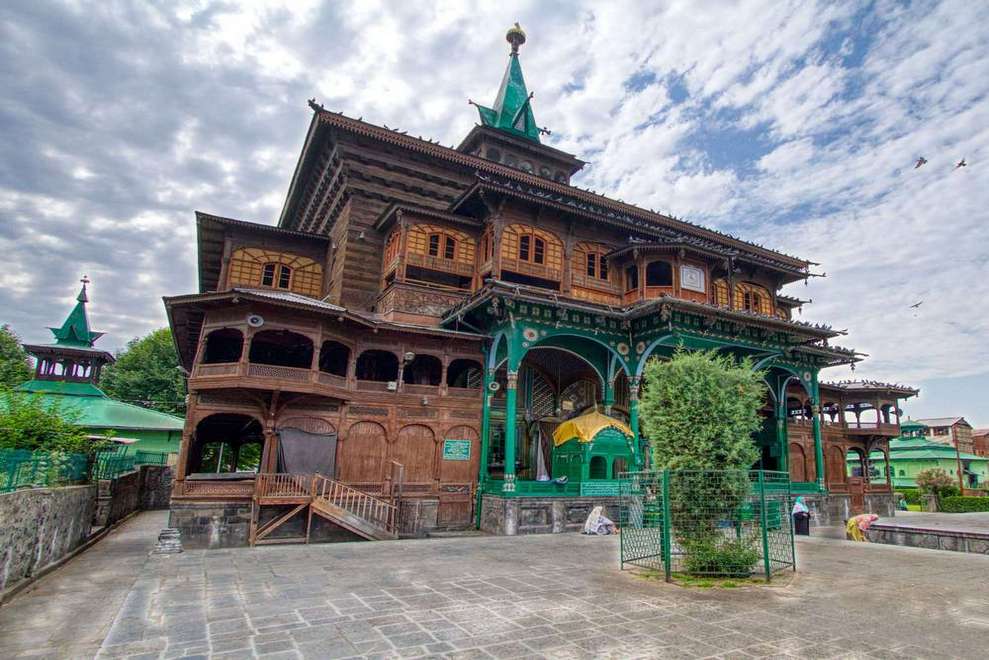
Tourist Places and Sightseeing in Srinagar
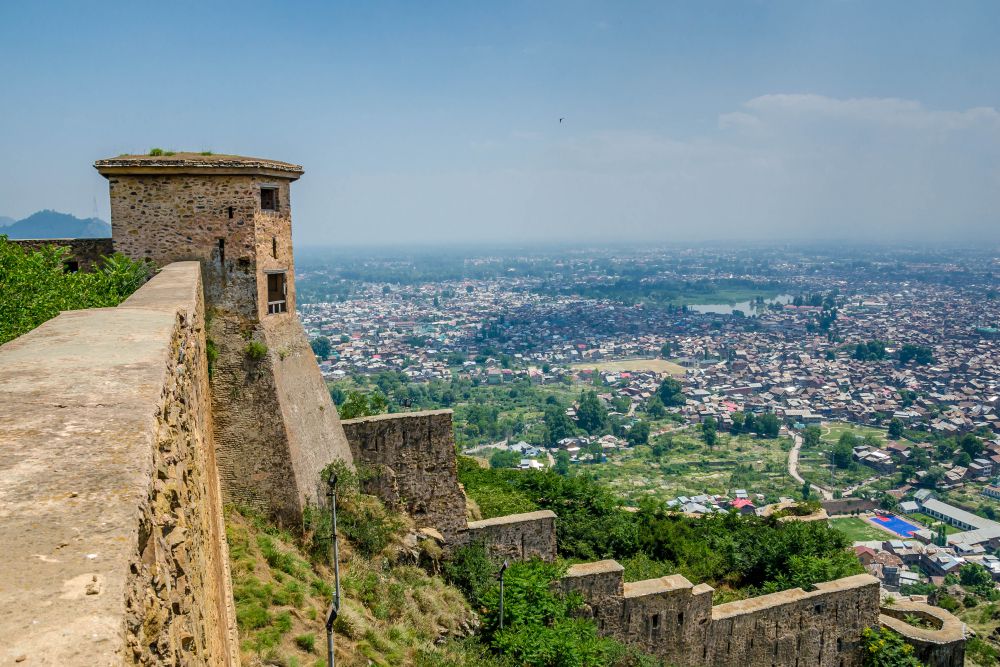
Hari Parbat Fort
Hari Parbat, a majestic hill visible from most sections of Srinagar, is located in the heart of the old city, 5 kilometers from the city center. The hillock, also known as 'Koh-e-Maran' and 'Predemna Peet,' offers a panoramic view of the entire ancient city. A straggly spread of Dal Lake separates the formidable hillock from the huge Zabarwan mountain range.
It houses the heritage and holy monuments of utmost importance, including the 'Parvati Temple,' 'Chatti Padshahi Gurudwara,' 'Makhdoom Sahib Shrine,' and 'Akhund Mullah Shah Shrine.' On top of this hill stands the only and most prominent identity marker of Srinagar, the Hari Parbat fort.'
The location was first fortified in 1590 by Mughal Emperor Akbar. He built an outside wall for the fort and planned to establish a new capital, 'Nager Nagor,' within it, but the project never got off the ground. Many people believe that the wall of Hari Parbat, which stretches over 5 kilometers, is the longest and oldest wall in the subcontinent.
Hokersar Wetlands
Hokersar Wetlands, in the Zainakote neighborhood of Srinagar, are the largest of Kashmir's nine wetlands and are only 10 kilometers from the city center. It is regarded as the 'Queen Wetland of Kashmir,' and it welcomes around seven lakh migrating birds every year. It is spread out over 13.75 square kilometers.
If you enjoy birdwatching, come to Hokersar when winter arrives in the northern hemisphere at the end of September. Scores of avian species from Siberia, Central Asia, and North Europe flock to the area. Gadwall, garganey, mallard, common merganser, northern pintail, common pochard, ferruginous pochard, red-crested pochard, white eye pochard, northern shoveller, common teal, and Eurasian Wigeon are among the winter visitors at Hokersar.
Kathi Darwaza
Where Kathi Darwaza ends, it leads to the main entrance to the Hari Parbat fort. The central feature of this design is a vaulted room with side cavities. Persian inscriptions can be found on the ceiling and the walls of the doorways, which provide information on Persian cargo. Even in the company of the Great Mughals, customs and culture existed. Sangin Darwaza is another fascinating gate in the castle.
Sri Pratap Singh Museum
Sri Pratap Singh Museum, on the left bank of the Jhelum River in Lal Mandi, Srinagar, is a popular destination for both locals and tourists. It is one of Kashmir's oldest museums, having been established in 1898 under Maharaja Pratap Singh's reign.
The museum houses antiquities ranging from prehistoric to modern eras, including armor, weaponry, manuscripts, paintings, textiles, coins, and more. Paleontologists, historians, and art lovers will find a wealth of information and historical items at the museum, which covers Jammu, Kashmir, Gilgit, and Baltistan.


